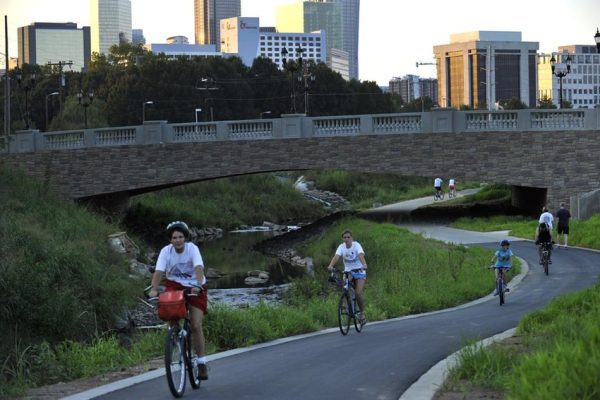Keeping the conversation about public space alive past coronavirus

Projects that usually take years are happening in weeks during the coronavirus pandemic: Cities are closing streets to cars, opening public space for sidewalk cafes and investing more in pop-up parks and outdoor amenities.
Planners are responding to a desperate desire for more public, outdoor space, as restaurants, gyms, bars, concert venues, offices, schools and other indoor gathering places remain closed or severely restricted. In Charlotte, city officials have closed about two miles of streets near parks to through traffic, in order to give people more room that’s usually been reserved for cars.
The question, though, as restrictions begin lifting and people crave a return to some kind of normalcy, is whether such changes represent a permanent shift or a fleeting blip in our car-centric culture. There’s already evidence that, after a precipitous drop-off, people might be starting to return to pre-pandemic levels of driving across the U.S.
U.S. driving nears pre-Covid levels, per @deutschebank‘s Torsten Slok. pic.twitter.com/VvKPZpcYIL
— Ben White (@morningmoneyben) May 13, 2020
Charlotte’s “shared streets” program is defined as a pilot, which the city could extend, expand — or do away with. Though some city officials are enthusiastic, there’s no clear road map for implementing such a plan long-term.
On the first weekend of #SharedStreets Charlotte, the demand shows that we need to close more streets, and with an eye towards making this a permanent change if we want a healthier and more pedestrian/cycler friendly city for everyone! https://t.co/zElXh4WZeG
— Julie J Eiselt (@JulieEiselt) May 10, 2020
In a “Coast to Coast” forum hosted by the Knight Foundation this week, planners offered several ideas on how to keep the current momentum around public spaces going — especially public spaces that equitably serve communities.
[Read all of our coronavirus-related stories here]
Focus on public spaces as infrastructure, not luxury amenities
With the U.S. plunged into a deep recession, one thing is near certain: A flood of federal and state stimulus money is coming. And infrastructure projects have generally been popular spending targets.
“No matter who gets elected, there’s certainly going to be investment in infrastructure,” said Stephen Gray, urban design professor at Harvard Graduate School of Design.
Infrastructure is often taken to mean roads, bridges, a new airport, a flashy new light rail line. But planners said infrastructure should be redefined to include public spaces like neighborhood parks, plazas, libraries, greenways, trails and other gathering spaces.
“There’s always an infrastructure bill,” said Carol Coletta, president and CEO of the Memphis River Parks Partnership. Now’s the time to take advantage of interest in public space to capture some of the available funding.
“Public space, especially parks, has been rediscovered as the asset it is to communities,” she said.
Alexa Bush, urban design director for the Detroit Planning Department’s East Region, said this will require changing the way we’ve traditionally viewed well-designed public spaces as amenities for nicer parts of town.
“They can’t be seen as a luxury good. They really need to be deployed everywhere, for everyone”
Make incremental changes
Bush recalled a three-year project to build a new park in Detroit.
“That felt like light speed” for government, she said. But for people in the public waiting to see changes, that can feel like a long, long time.
Putting smaller, temporary changes in place in the meantime — such as a parklet on a gravel lot instead of leaving nothing until the fully built park is in place — can get people excited about the changes. And such changes can convince people that change is actually coming, and local government isn’t making empty promises.
Incremental plans can also help build a sense of place on a disused area before a major project is built, like the skate park and outdoor market on the former Eastland Mall site. However, that can pose its own problems: Developers and planners might face backlash when popular temporary amenities are removed, as is the case at Eastland Mall.
Coming back to this. I want to emphasize what a big deal it is that Eastland will be losing the open-air market and skate park. The market, started 5 years ago, has become a place where local farmers, cooks, and artisans sell everything from fresh fruit to empanadas to clothing. https://t.co/p2YPi0ypPV
— Katie Peralta (@katieperalta) May 13, 2020
Use this pause for planning
Even if there is a big infrastructure bill in the next few years, there’s likely to be a pause in projects as state and local governments deal with the budgetary fallout from the pandemic.
All three planners counseled using that time to push for better designs and ideas to benefit all parts of the community equitably.
“I think we should all reject complacency about design of public spaces,” said Coletta. “We’re far too quick to accept mediocre.”
A pause in building could allow for more thoughtful or daring designs. And it could give planners time to push for equity as a central tenet of new public spaces, whether in where new parks and trails are built, how they’re designed and how higher tax revenue from surrounding properties is allocated.
Gray gave the example of the High Line in New York City, a repurposed elevated rail line that’s now a linear park. Increased tax revenues generated by the project don’t go specifically to the surrounding neighborhood, but rather into the general fund.
Gray said planners should explore ideas to capture the tax revenue and invest it to improve the surrounding neighborhood so local residents see a benefit, especially in areas where gentrification is likely to occur.
Looking hard at such questions now will allow planners to move quickly when funding is available, said Gray: “Our project is not only a shovel-ready project, but it’s going to have this kind of equity impact.”